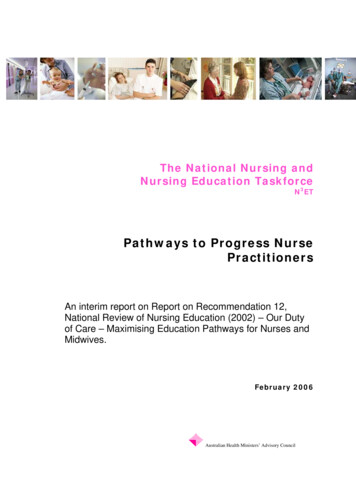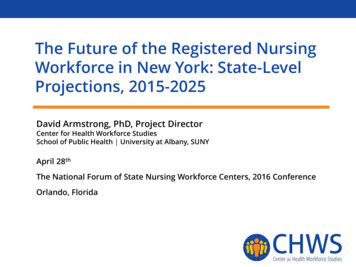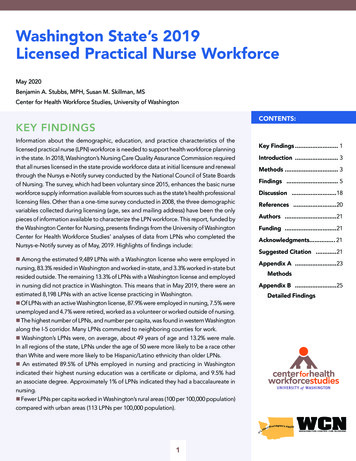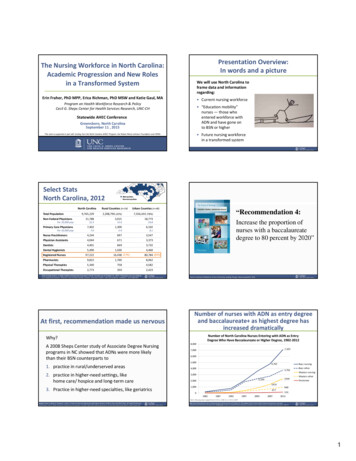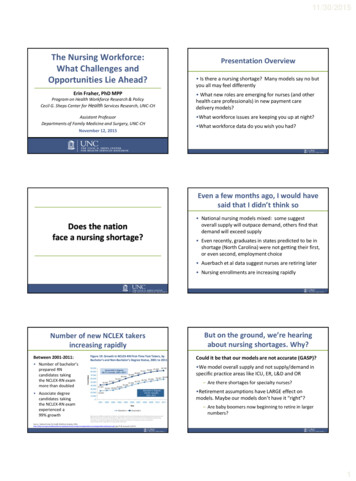
Transcription
11/30/2015The Nursing Workforce:What Challenges andOpportunities Lie Ahead?Erin Fraher, PhD MPPProgram on Health Workforce Research & PolicyCecil G. Sheps Center for Health Services Research, UNC-CHAssistant ProfessorDepartments of Family Medicine and Surgery, UNC-CHNovember 12, 2015Presentation Overview Is there a nursing shortage? Many models say no butyou all may feel differently What new roles are emerging for nurses (and otherhealth care professionals) in new payment caredelivery models? What workforce issues are keeping you up at night? What workforce data do you wish you had?Even a few months ago, I would havesaid that I didn’t think soDoes the nationface a nursing shortage? National nursing models mixed: some suggestoverall supply will outpace demand, others find thatdemand will exceed supply Even recently, graduates in states predicted to be inshortage (North Carolina) were not getting their first,or even second, employment choice Auerbach et al data suggest nurses are retiring later Nursing enrollments are increasing rapidlyNumber of new NCLEX takersincreasing rapidlyBetween 2001-2011:Figure 19: Growth in NCLEX-RN First-Time Test Takers, byBachelor’s and Non-Bachelor’s Degree Status, 2001 to 2011 Number of bachelor’sprepared RNcandidates takingthe NCLEX-RN exammore than doubled Associate degreecandidates takingthe NCLEX-RN examexperienced a99% growthBut on the ground, we’re hearingabout nursing shortages. Why?Could it be that our models are not accurate (GASP)? We model overall supply and not supply/demand inspecific practice areas like ICU, ER, L&D and OR– Are there shortages for specialty nurses? Retirement assumptions have LARGE effect onmodels. Maybe our models don’t have it “right”?Data Sources: HRSA compilation of data from the National Council of State Boards of Nursing, Nurse Licensure andNCLEX Examination Statistics Publications, 2002-2012, and from the National Council of State Board of Nursing,“Number of Candidates Taking the NCLEX Examination and Percent Passing, by Type of Candidate,”https://www.ncsbn.org/Table of Pass Rates 2011.pdf– Are baby boomers now beginning to retire in largernumbers?Source : National Center for Health Workforce Analysis, report.pdf , pgs 37-38, accessed 11/5/15.1
11/30/2015Maybe we’re notmodeling demand correctly? Demand is up due to a better economy, increasedinsurance coverage and aging population Demand has increased in outpatient settings,including community-based organizations, soinpatient nursing - which has always been popular is now competing with other settingsAttrition seems to be on the rise,FTE on the decline Attrition of new nurses seems to be increasing. Why? BSNs are not staying the workforce—they want tobecome advanced practice nurses and are leaving theworkforce to go back school Gen Ys don’t want to work as many hours and are nottaking on extra shiftsMaybe there is a mismatch between whateducators produce and employers want? Hospitals want experienced nurses and are not hiringnew grads because they are not graduating with theclinical expertise that hospitals want Health systems are seeking nurses that can take onnew roles in patient engagement, care coordination,informatics (more on that later .)Other reasons why our modelsmay not be correct Hiring internationally trained nurses has becomemore difficult Payment models are changing—maybe value-basedpayment models employ more nurses? Other?But let’s shift the dialogue Focusing on whether we have a nursing shortagedistracts us from a more important question:Will we have the right mix of nurses in theright locations, specialties and practice settingswith the skills and competencies needed to meetthe demands of a transformed health care system?The future nursing workforce:New roles in a transformedhealth system2
11/30/2015Let 1,000 flowers bloom: ongoing experimentsin health system transformationNew models of care:key characteristicsGoal: provide patients with more comprehensive, accessible,coordinated and high quality care at lower costs Growing number of patientcentered medical homes,accountable care organizationsand integrated delivery systems Emphasis on primary, preventive and “upstream” care Care is integrated between:– medical sub-specialties, home health agencies and nursing homes– health care system and community-based social services CMS actively fundingdemonstration projects EHRs used to monitor patient and population health—increaseduse of data for risk-stratification and hot spotting Secretary Burwell recentlyannounced 50% of Medicarepayments tied to value by 2018 Interventions focused on both patient- and population-level Payment based on value, not volumeNursing in a Transformed Health CareSystem: New Roles, New Rules PCMHs and ACOs emphasize care coordination, populationhealth management, patient education, health coaching,data analytics, patient engagement, quality improvement, etc.“What will it take to optimizecontributions of nurses? Redesign the nursing curriculum toeducate nurses with new competencies; Retrain existing nurses with new skills andknowledge; Revamp licensing examination andrequirements to reflect the new curriculum;and Restructure the state regulatory systemto allow flexible deployment of the nurseworkforce.”-Quoted from Janet Weiner, MPH. Penn LDI Voices Blog. “Re: Nurses”.June 25, 2015. w do nurses fit innew models of care? Care and the workforce shifting toward ambulatory settingsand community care New job titles and roles are emerging Increase focus on integrated care delivery models creating“boundary spanners”http://ldi.upenn.edu/uploads/media : Fraher E, Spetz J, Naylor M. Nursing in a Transformed Health Care System: New Roles, New Rules.LDI/INQRI Research Brief. June 2015. http://ldi.upenn.edu/uploads/media : Bodenheimer T, Berry-Millett R. Care management of patients with complex health care needs. Princeton, NJ: Robert Wood JohnsonFoundation; 2009.Boundary spanningroles growing quicklyHow do we redesign structuresto support new roles?Education Increasing number of staff focused on roles that shiftfocus from visit-based to population-based strategies Need to redesign education system so nurses can flexibly gainnew skills and competencies Two examples: Retrain and upgrade skills of the 2.9 million nurses already inthe system – they are the ones who will transform carePanel ManagersHealth CoachesAssume responsibility forpatients between visits. UseEHRs and patient registries toidentify and contact patientswith unmet care needs. Oftenmedical assistants but can benurses or other staffImprove patient knowledgeabout disease or medication andpromote healthy behaviors. Maybe medical assistants, nurses,health educators, social workers,community health workers,pharmacists or other staff Training must be convenient – timing, location, andfinancial incentives must be taken into consideration Need to prepare faculty to teach new roles and functions Clinical rotations need to include “purposeful exposure” tohigh-performing teams and ambulatory settingsSource: Fraher E, Spetz J, Naylor M. Nursing in a Transformed Health Care System: New Roles, New Rules. LDI/INQRI Research Brief. June 2015; Ladden et al. The Emerging PrimaryCare Workforce. Preliminary Observations from the Primary Care Team: Learning from Effective Ambulatory Practices Project”. Academic Medicine; 1013, 88(12): 1830-1835.3
11/30/2015Macy Foundation hosting spring meetingon transforming nursing educationConference will examine issues related to preparing registered nurses forenhanced roles in primary care identify curricular priorities and strategies for undergraduatenursing students and existing registered nurses, address challenges to change in registered nurse workforcetraining and implementation, and develop actionable recommendations for local, regional andnational efforts to better prepare nurses for primary care rolesHow do we redesign structuresto support new roles?Regulation“The workforce innovations needed to implementACA programs require an adaptable regulatory systemcapable of evolving with the health care environment.The health profession regulation system in place todaydoes not have the flexibility to support change.”To create a more dynamic regulatory system, we need: to develop evidence to support regulatory changes, especially for new roles better evaluation of pilot workforce interventions to understand if interventionsimprove health, lower costs and enhance satisfaction to establish a national clearinghouse to provide up-to-date and reliableinformation about scope of practice changes in other states Remove regulatory barriers to let nurses utilize skills to max benefit of patientsSource: Dower C, Moore J, Langelier M. It is time to restructure health professions scope-of-practice regulations to remove barriers to care. Health Aff (Millwood).2013 Nov;32(11); Fraher E, Spetz J, Naylor M. Nursing in a Transformed Health Care System: New Roles, New Rules. LDI/INQRI Research Brief. June 2015.But how do we redesign structuresto support new roles?Policy Insurance reimbursement rulesWho is going to pay for all thisretooling we need to do?Payment Adequate and sustainable payment models to retool andredeploy the workforce are lacking Regulation of entry-level nursing education NCLEX Federal and state appropriations to spur innovationWhat policy changes would better support the waythat you want to deploy nurses? Many workforce innovations are supported by one-timefunds. If payment models don’t change rapidly enough, willthese interventions be sustainable? 1,000 flowers are blooming but are adequate dollars availableto conduct research and evaluations necessary to developevidence base needed to support workforce redesign?Source: Fraher E, Spetz J, Naylor M. Nursing in a Transformed Health Care System: New Roles, New Rules. LDI/INQRI Research Brief. June2015.Why the nursing workforce is criticalto health system transformationWhat workforce issues are keepingyou up at night? With nearly 3 million nurses in active practice, nursing isby far largest licensed health profession (about fourtimes as many nurses as physicians) Nursing care linked to quality and satisfaction measuresthat will increasingly be tied to value-based payments What data do you wish you had? What are your questions? Nurses provide whole-person care across health andcommunity-based settings Nurses are the ultimate “flexible” workforce taking onnew roles in transformed health system4
11/30/2015Contact infoErin Frahererin fraher@unc.edu(919) 966-5012Program on Health Workforce Research and Policyhttp://www.healthworkforce.unc.edu5
Nursing care linked to quality and satisfaction measures that will increasingly be tied to value-based payments Nurses provide whole-person care across health and community-based settings Nurses are the ultimate "flexible" workforce taking on new roles in transformed health system What workforce issues are keeping you up at night?







